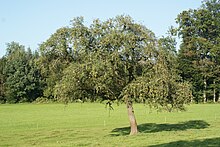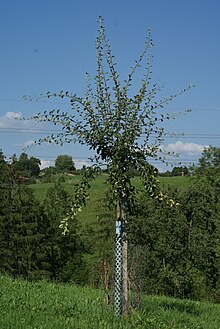Theilersbirne
The Theilersbirne is a Swiss variety of the pear ( Pyrus communis ).
Synonyms
Synonyms for Theilersbirne are Theilingsbirne, Streuler, Streuli-Birne, Sträuli, Zugerbirne, Zuger Mostbirne, Lucerne Fässlibirne.
Origin and Distribution
The variety probably comes from Wädenswil on Lake Zurich (Switzerland). It is one of the most common cider pear varieties in Switzerland. It is most widespread in the Swiss cantons of Zurich , Zug , Lucerne and Schwyz , where, according to Pfau-Schellenberg, around 1863 it made up around half of all pear trees. In many communities on the left bank of Lake Zurich, their share of the pear population was over 90% at times.
tree
The variety makes little demands on the location and also thrives at higher altitudes. Kohler writes that the tree is sensitive to moisture. The variety usually flowers in mid-April and is not very sensitive to cold. The tree bears early and is very fertile. It has a strong stature with a high pyramidal crown. You can easily recognize the variety by the drooping growth and the silvery leaves. The young tree grows beautifully and forms healthy, strong shoots. The branches are horizontally protruding and hanging. The summer shoots are strong, straight, reddish-brown and somewhat woolly towards the tip. The small leaf has entire margins, glossy dark green on the upper side and whitish-fluffy on the underside. The tip of the leaf is downward, the leaf margins upwardly curved and wavy.
fruit
The fruit is small and regularly ovoid. The stem is short, thin, sessile and slightly thickened towards the base. The calyx pit is only indicated with small bulges and ribs and partly rusted. The skin is smooth and slightly rusted everywhere. The basic color is white-green to yellow-green depending on the maturity, the covering color is missing. The meat is yellowish, firm, fine-grained, sweetish, but only juicy when doughy.
use
The Theilersbirne is an excellent and well-known burning pear. Mixed with sour apples, it makes a very good must (67 ° Oechsle). In times of war large quantities of pear pears were dried. In central Switzerland it is traditionally used for the production of Birähung ( pear honey ). In French-speaking Switzerland it is used cuit for Vin.
Harvest time and storage
The fruits are harvested in early to mid-September.
Diseases
The variety is very susceptible to scab.
Individual evidence
- ↑ Szalatnay, Kellerhals, Frei, Müller: Fruits, Berries, Nuts. 2001, p. 576.
- ↑ Kohler: List and description of the most important core fruit varieties of the Canton of Zurich. 1864, p. 80.
literature
- J. Michael Kohler: List and description of the most important core fruit varieties of the Canton of Zurich, organized by the Zurich Association for Agriculture, edited using the various agricultural Materials communicated to community associations. Printed by Schiller & Comp., Zurich 1864, p. 80 .
- Hans Kessler: Pear varieties of Switzerland. Published by the Swiss Fruit Association in Zug, with 40 illustrations in eleven colors, 10 outline drawings and 78 sectional drawings. Verbandsdruckerei AG book publisher, Bern 1948, p. 109.
- Josef Löschnig : The cider pears. Description of the most commonly planted cider pear varieties in Austria. Published by the Austrian Fruit Growing and Pomologists Society with the support of the KK Agriculture Ministry. Processed by the manager with the participation of members of the company. Friedrich Sperl, Vienna 1913, p. 174.
- Swiss Agricultural Central Association (Ed.): Swiss fruit varieties. Volume 2: pears. Expedition by Scheitlin and Zollikofer, St. Gallen 1863.
- David Szalatnay, Markus Kellerhals, Martin Frei, Urs Müller: Fruits, berries, nuts. The variety of varieties - 800 portraits. Haupt, Bern et al. 2011, ISBN 978-3-258-07194-7 , p. 576.


